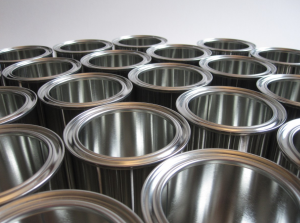In the surface finishing industry, the term “anodizing” is very common and is frequently mentioned – but what is anodizing exactly?
What does anodizing mean?
Anodizing is a process that converts the surface of a non-ferrous metal into a corrosion-resistant, decorative, non-conductive oxide. It is a very common finishing technique for aluminum, although other metals such as titanium and magnesium can also be anodized. This process is common amongst several applications from aerospace to food services. Its ability to protect aircraft from corrosion and stray currents is vital to the success of the aerospace industry. Its high heat and corrosion resistance make for an ideal coating for food service. It is also commonly used in building materials, optics, defense, and medical industries.
What is the Anodizing Process?
In order to create the oxide coating, clean parts are submerged in an electrolyte solution along with cathodes to create an electrolytic cell within the solution. A current is applied to the parts that produce oxygen on the surface. The interaction of the metal, electricity, and electrolyte produces the oxide coating required. The current applied, the temperatures at which the coatings are formed, the concentration and type of electrolyte all play a role in the features of the coating formed. Further operations can be utilized to dye the surface an endless array of colors, and parts can be sealed to aid in corrosion prevention and color stability.
Types of Anodizing
There are three main categories, defined by MIL-A-8625 as:
- Type I: Chromic Acid Anodizing
- Type II: Sulfuric Acid Anodizing
- Type III: Hard Sulfuric Anodizing
Chromic Acid Anodizing (Type I) produces the thinnest oxide coating, typically at 0.00002”-0.0001”. Although extremely thin, this coating imparts corrosion protection in line with other types of anodizing without major dimensional changes. Chromic acid anodizing is not readily accepting of dye due to the thin nature of the coating.
Sulfuric Acid Anodizing (Type II) is the most commonly used application. The coating is typically 0.0001”-0.001” thick and is harder and more wear-resistant than chromic acid anodizing. It is also easily dyed to produce parts of an endless variety of colors. Parts can be sealed to further protect the color and base material from corrosion.
Hard Sulfuric Anodizing (Type III) utilizes special techniques to form a thicker, more wear and abrasion-resistant coating, typically in the 0.001”-0.002” range. Due to the coating formed, parts that have been hard anodized are usually dyed black, although recent advances in technique have allowed for a greater variety of colors to be utilized in the hard anodizing process.
Benefits of Anodizing
Anodizing is a common coating because of the numerous benefits it offers. These advantages include but are not limited to:
- Durability – The wear and corrosion resistance extends the life of the parts which have been anodized without any chipping or peeling.
- Health and Safety – The naturally occurring oxides produced during the process is chemically stable, non-toxic, and will not decompose.
- Aesthetics – The availability of a virtually unlimited color pallet ensures a visually appealing surface.
- Environmental – Parts that are recyclable remain recyclable after the process without stripping or other materials removal processes.
- Ease of Maintenance – Parts that have been anodized can easily be cleaned with mild soaps and water without damaging the anodized surface.
Contact the Surface Finishing Experts
Silvex specializes in a wide variety of finishes, processed to ISO 9001:2015, NADCAP, and AS91000D standards. Our diverse experience has enabled us to excel in the surface finishing industry.
To speak with our experts about a surface finishing project, please contact us today.

